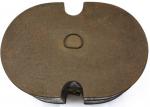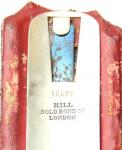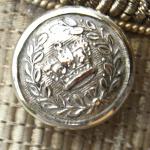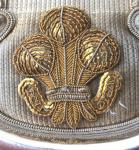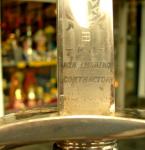-
Posts
13,225 -
Joined
-
Last visited
-
Days Won
22
Content Type
Profiles
Forums
Blogs
Gallery
Events
Store
Everything posted by Mervyn Mitton
-
Does anyone else think the two 'LL's' in his name seem to be a different style ?
-
All the best things date from 1936 !
-

Chinese Shanghai River Police badge
Mervyn Mitton replied to GeorgeCL's topic in Police Forces of the World
Hello - 'Shanghaigirl' - George will no doubt reply to you when he sees your post - meanwhile - welcome to the Forum. Thank goodness you called yourself by this name and not 'Shanghai Lil' - who was of course a very notorious 'lady' in the history of the settlement. There are so few dedicated collectors for the pre-war Shanghai units - the material is scarce. Perhaps you would post some of your collection and fill in the 'cracks' in our knowledge. Obviously , you are hoping for George's River Police badge - so, so rare. However, I personally would consider selling the officer's cap badge I illustrated. Let me know if any interest. We don't seem to have many members in Hong Kong - what is your background ? The head office of a company I worked for in Bangkok in the '60's was in Hong Kong - lovely place - just too many people. -
Last week I had this superb pair of silver officer's epaulettes come-in. Thought I would post them to give a 'bit of colour' back to the forum. They are Victorian and I have tentatively dated them to the 1880's - however, it is not impossible that the Crown on the dress button could be William 4th (1830-37). With the Prince of Wales Feathers the link to one of his named regiments is obvious - but, which one ? I have - for the present - shown them as the 12th Lancers. I think this heavy pattern of epaulette was common for Cavalry, to protect against downwards sword strokes. However, full dress uniforms from those days had some very fanciful trappings and I am hoping the membership will be able to make a positive identification. The workmanship is typically British of that era - even to a stamp saying left and right. I have not been able to find out anything further about the maker - only that they were top regimental tailors.
-

DCM gratuity....
Mervyn Mitton replied to The Monkey God's topic in Great Britain: Orders, Gallantry, Campaign Medals
Bernard - I'm afraid I can't entirely agree with this thinking. Yes - the soldiers may have thought they would like the £10 annual payment - but, to save this amount was not the purpose of the new award. The Distinguished Conduct Medal ia a high award and the difficulty the authorities had, was that not every act qualified for it's criteria. Also, the only award for o/r's above the DCM was the VC. There was a similar difficulty with officers' awards and so, in 1916 they created the MC for officers' below Major ( and on some occasions to Wt. Offs.) and the MM , for NCO's and O/R's. There were some 145,000 Military Medals awarded for bravery in the 1st World War. Effectively, it created a third level of gallantry medals and allowed the DCM to keep it's high place. -

VICTORIA CROSS 'MYSTERY'
Mervyn Mitton replied to Mervyn Mitton's topic in Great Britain: Orders, Gallantry, Campaign Medals
It has been quite common in British graveyards over the past few years, to remove old unvisited graves. This frees up space. The photo of the original grave was definite on how it belonged to someone else, so, in all probability there will be no trace of him. I very much doubt that the mystery will ever be solved. He probably came here as a migrant and either had his name changed - or, did so himself - leaving only reference to his Country of origin. -

ANOTHER BRIT. OFFICER'S SWORD
Mervyn Mitton replied to Mervyn Mitton's topic in Swords & Edged Weapons
Jonathan - thank you for taking so much time and trouble. Also, please thank Mr. Wilkinson Latham - his input is greatly appreciated - I do have his ref. books. You will have seen the surprising reply from Paul Herman - whose family owned the original suppliers. Although he says Wilkinsons's supplied the swords , there are, of course, variations with suppliers and it would seem that this is such a case. I am hoping that Paul will be able to help us a little more with this identification - and also, tell us more about the Company. My very best wishes for Christmas and a good 2010. -

ANOTHER BRIT. OFFICER'S SWORD
Mervyn Mitton replied to Mervyn Mitton's topic in Swords & Edged Weapons
Dear Paul - firstly, welcome to GMIC. With your background you will be an invaluable source for Sth. African information and I am sure many members will be as surprised as I was to see your reply. I know that Jonathan will be pleased. Unfortunately this sub-forum does not get a great response - which is a pity - swords, bayonets and knives are an important collecting subject. Your family business was so obviously a well known one, that I reproach myself for not recognising it - however, although I lived in Durban in the 1950's I was not in the Services. Are you still in business in Canada - or, have you - sensibly - retired ? Once again , thankyou for giving us this info. - incidentally, the sword is available . -
Ed - these are in lovely condition. Are you specialising in Austrian now ?
-
Bob - your continuing posts still amaze me with the sheer number and variety of the badges. I see the latest ones are featuring a lion - does that mean that the 'dead chicken' symbol, went out with Saddam ? Sorry - I think I should qualify that comment. The earlier ones really did look like a chicken - or at least I thought so - however, the eagle was much better on the later ones.
-
Hi - Russ. Firstly - welcome to GMIC, nice to have another ethnic collector. With this old post coming back-up I have just realised that I owe a reply to 'pazulu' - my sincere apologies. Looking at your collection, I would say that they are all from East Africa - the original owner possibly lived there and put them together - I would date them to 1920/30's. Starting with the one on the left, it could be from any one of a number of tribes - the small head is quite common and is a result of not having access to a lot of iron - unlike the Zulus in Natal. Second - this is typical of many fish spears from East Africa - mostly tribes who live along the numerous lakes. The double ended barb beneath the spear head can help to capture the fish when first thrust -in and will hold a large fish when pushed right through. Third from left is also a fishing spear - but more in the shape of a harpoon with the barbs forming part of the head. Again typical of East Africa - and you must remember that the lakes are so vast that there are really big fish and animals in them. The last one looks like a Masai - or an associated tribe. The test will be, does the bottom end have a metal sheath for the last 18 inches (approx) and ending as a spike ? The Masai and their cousins are lion hunters and if the lion charges they stick the bottom end in the ground - direct the head at the charging lion - and pray !! Normally, they surround the lion and throw the spear. Value wise - an old Masai spear in good condition, can fetch up to (approx) £70 ($100). The others about the same - perhaps a little less - although the fishing ones are good decorative items. Hope this helps.
-
Gordon - a strange item, being the same thickness along ther length. The raised band must be to stop it falling through a belt holder. I know a number of East European countries used a type of plastic moulded truncheon - the old East Germany comes to mind. Hopefully someone will come-up with an ident..
-

ANOTHER BRIT. OFFICER'S SWORD
Mervyn Mitton replied to Mervyn Mitton's topic in Swords & Edged Weapons



